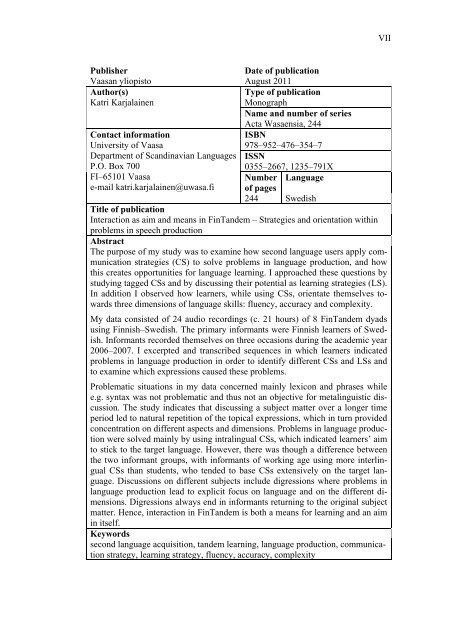Interaktion som mål och medel i FinTandem - Vaasan yliopisto
Interaktion som mål och medel i FinTandem - Vaasan yliopisto
Interaktion som mål och medel i FinTandem - Vaasan yliopisto
You also want an ePaper? Increase the reach of your titles
YUMPU automatically turns print PDFs into web optimized ePapers that Google loves.
Publisher Date of publication<br />
<strong>Vaasan</strong> <strong>yliopisto</strong> August 2011<br />
Author(s) Type of publication<br />
Katri Karjalainen<br />
Monograph<br />
Name and number of series<br />
Acta Wasaensia, 244<br />
Contact information ISBN<br />
University of Vaasa<br />
Department of Scandinavian Languages<br />
P.O. Box 700<br />
FI–65101 Vaasa<br />
e-mail katri.karjalainen@uwasa.fi<br />
978–952–476–354–7<br />
ISSN<br />
0355–2667, 1235–791X<br />
Number Language<br />
of pages<br />
244 Swedish<br />
Title of publication<br />
Interaction as aim and means in <strong>FinTandem</strong> – Strategies and orientation within<br />
problems in speech production<br />
Abstract<br />
The purpose of my study was to examine how second language users apply communication<br />
strategies (CS) to solve problems in language production, and how<br />
this creates opportunities for language learning. I approached these questions by<br />
studying tagged CSs and by discussing their potential as learning strategies (LS).<br />
In addition I observed how learners, while using CSs, orientate themselves towards<br />
three dimensions of language skills: fluency, accuracy and complexity.<br />
My data consisted of 24 audio recordings (c. 21 hours) of 8 <strong>FinTandem</strong> dyads<br />
using Finnish–Swedish. The primary informants were Finnish learners of Swedish.<br />
Informants recorded themselves on three occasions during the academic year<br />
2006–2007. I excerpted and transcribed sequences in which learners indicated<br />
problems in language production in order to identify different CSs and LSs and<br />
to examine which expressions caused these problems.<br />
Problematic situations in my data concerned mainly lexicon and phrases while<br />
e.g. syntax was not problematic and thus not an objective for metalinguistic discussion.<br />
The study indicates that discussing a subject matter over a longer time<br />
period led to natural repetition of the topical expressions, which in turn provided<br />
concentration on different aspects and dimensions. Problems in language production<br />
were solved mainly by using intralingual CSs, which indicated learners’ aim<br />
to stick to the target language. However, there was though a difference between<br />
the two informant groups, with informants of working age using more interlingual<br />
CSs than students, who tended to base CSs extensively on the target language.<br />
Discussions on different subjects include digressions where problems in<br />
language production lead to explicit focus on language and on the different dimensions.<br />
Digressions always end in informants returning to the original subject<br />
matter. Hence, interaction in <strong>FinTandem</strong> is both a means for learning and an aim<br />
in itself.<br />
Keywords<br />
second language acquisition, tandem learning, language production, communication<br />
strategy, learning strategy, fluency, accuracy, complexity<br />
VII

















